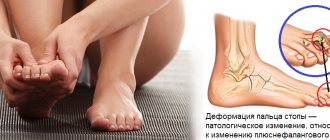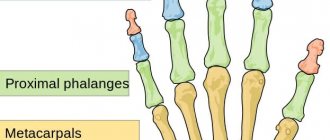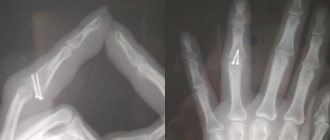When a person feels numbness in their legs
, this means that the sensitive part of the peripheral nerve is affected. Not only sensitivity is lost, but also burning and tingling, tightness, “cottoniness”, goosebumps, coldness, sometimes the accuracy of movements is impaired and a feeling of uncertainty when walking and dizziness occurs. The nerves of the lower limb are numerous, begin in the spinal cord, and branch along their course into many branches. The legs receive nerve impulses through both large (femoral, sciatic, tibial) and small nerves. The central analyzer of sensitivity is the structures of the brain.
The nerves of the lower limb can directly receive mechanical damage (for example, bony outgrowths of the vertebrae, so-called osteophytes, “ossified” ligaments, herniated intervertebral disc), and also be damaged as a result of the inflammatory process or metabolic (metabolic) disorders. CELT doctors, who have modern diagnostic equipment at their disposal, will help you find the cause.
At CELT you can get advice from a neurologist.
- Initial consultation – 3,500
- Repeated consultation – 2,300
Make an appointment
Do you always need to see a doctor?
There is no need to worry only if there is numbness
left or
right leg
occurs once after an uncomfortable position (what is popularly called “served time”). Soon after the physiologically normal posture is restored, the numbness should also disappear. Other harmless reasons include:
- Hypothermia - the human body reacts to cold starting from the lower extremities, so it is best to keep them warm;
- Wearing ill-fitting shoes that are too tight or narrow can lead to numbness in your toes
; - Bearing a fetus - a symptom occurs due to an increase in the volume of fluid in a woman’s body;
- A sedentary lifestyle and frequent sitting leads to numbness in the feet
and legs below the knee.
In all other cases, especially when numbness recurs regularly, it is imperative to look for the cause. Most likely, some pathological process is occurring in the body, and given the extreme “fragility” of nerve fibers and the complexity of their regeneration, delaying diagnosis can lead to irreversible consequences. The following points should be of particular concern:
- there is no obvious reason for the numbness, but it often recurs;
- problems with coordination arise, the leg “clings” or “stammers”;
- walking becomes difficult;
- difficult or impossible to distinguish between warm and cold;
- worries about weakness or dizziness;
- urination is impaired.
These symptoms may indicate a circulatory disorder in the nervous system, that is, they may be signs of a stroke. Or they may indicate acute damage to the nervous system of some other etiology. With such disorders, the timing of medical care is important. For example, if it is possible to restore blood flow in the brain during the first three hours, then there may be no consequences in the form of paresis or paralysis or speech impairment. Modern medical technologies used in CELT make it possible to help those who had no chance yesterday.
Why can the tips of my toes go numb?
Factors contributing to the development of paresthesia (decreased sensitivity) may include:
- injuries, including minor ones (for example, due to wearing shoes that are too tight);
- neurological disorders, in particular after head or spinal injuries;
- spine pathologies;
- spinal cord injury;
- nerve compression;
- circulatory disorders, vascular diseases;
- endocrine pathologies;
- joint diseases.
It must be taken into account that diseases can be combined. For example, decreased sensitivity can be caused simultaneously by a disease of the spine and circulatory disorders.
Etiology
Most common causes of numbness in the legs
consist in the presence of pathological processes in the spine - however, this is not all. The etiology of this symptom may be as follows:
- arthritis;
- pathological conditions of a systemic nature;
- multiple sclerosis;
- blood flow disturbances.
The area in which the feeling of numbness is localized will help to more accurately determine the cause.
| Numb area | Diseases characterized by this symptom |
| Hips/thigh |
|
| Above the knees |
|
| Calves of the legs |
|
| Below the knees |
|
| Foot/feet |
|
| Numbness in left leg |
|
| Numbness in right leg |
|
Other causes of numbness
If your arms and legs are numb on both sides, then perhaps the spinal cord is being compressed due to a tumor, injury, hematoma, abscess (abscess), or it is a matter of peripheral polyneuropathy - damage to small peripheral nerves or disruption of their function. It is usually caused by certain medications, diabetes, chronic kidney disease, vitamin B12 deficiency, Lyme disease, or HIV infection. Most drugs that cause numbness include chemotherapy. As a rule, some time after the end of chemotherapy, sensitivity returns.
Diabetic neuropathy is a fairly common occurrence in patients with diabetes. The exact cause of the damage is unknown, but it is believed that metabolic disorders and destruction of small vessels occur, which leads to nerve damage. If numbness has already occurred, it is impossible to completely get rid of it. But the condition can improve if you monitor your blood sugar levels more closely. If the numbness is significant, then you need to follow the doctor’s recommendations to avoid injury to the limbs and subsequent complications.
Exactly how vitamin B12 deficiency disrupts the formation of myelin sheaths on nerves is unknown. But if this substance is not enough, then the legs, rather than the arms, often go numb. Also, a lack of vitamin B12 is accompanied by anemia and weakness. But numbness occurs only with a very serious deficiency. With treatment, symptoms go away within 3 months; in severe cases, recovery can take a year.
When chronic kidney disease worsens, uremia occurs—products of nitrogen metabolism and other toxic substances accumulate in the blood. This leads to peripheral nerve damage and numbness. This condition (uremic polyneuropathy) is an indication for dialysis or kidney transplantation.
Lyme disease and HIV infection can cause inflammation of some parts of the nervous system. With Lyme disease, numbness does not appear immediately, but already against the background of a flu-like state, from which the disease begins. Lyme disease is treated with antibiotics.
With HIV infection, numbness often occurs due to the fact that a weakened immune system allows the development of a cytomegalovirus infection, which affects the nerve fibers. Numbness usually occurs in people who are not taking antiretroviral therapy, which can greatly improve the condition of a person with HIV. Therefore, in order for the numbness to go away, you need to start specific treatment as early as possible.
Numbness and osteochondrosis
Why is osteochondrosis not on this list? The fact is that this diagnosis is not known anywhere except in the countries of the former Soviet Union. Usually they blame him for everything that they cannot explain. Degenerative changes in the spine are normal for anyone over 40 years of age. Numbness has other, real causes that can often be dealt with. Therefore, if you are diagnosed with osteochondrosis, you should consult another specialist.
Clinical manifestations
In pathological conditions, numbness of the legs is a symptom that is always accompanied by a number of others. Depending on the etiology, they may be different, but the general picture is approximately as follows:
- Feeling of heaviness in the lower extremities;
- Gait disturbances;
- Inability to distinguish cold from hot;
- Fatigue, constant weakness and weakness;
- Tingling and goosebumps;
- Cramps and increased pain at night;
- Sudden and sharp appearance of pain in the chest and spine;
- Itching and burning of the skin, sometimes blueness;
- Severe headaches and dizziness.
What does a person feel?
Numbness (paresthesia) is experienced subjectively. For example, as one of the manifestations listed below, any combination or complete complex.
- Loss of sensation.
- Burning.
- Inability to move fingers or bend them.
- Tingling with thousands of “needles”.
- Goosebumps.
- Itching.
- Discomfort.
Whatever the sensation, if a person’s toes are numb, treatment should be preceded by an adequate examination that will help identify the underlying causes of the disease.
Diagnostics
The use of modern instrumental diagnostic methods makes it possible to establish the cause quickly enough. Doctors have the following methods in their arsenal:
- radiography - reveals bone deformations, calcifications and other dense formations;
- - allows you to examine the bones and substance of the brain and spinal cord, and other soft tissues;
- MRI - detects defects in almost all structures, the vascular mode gives an objective picture of blood flow;
- electroneuromyography (ENMG of the lower extremities) - reveals defects in neuromuscular transmission;
- Ultrasound or sonography detects cysts, tumors and other formations, allows you to evaluate the structure of blood vessels;
- general clinical and biochemical blood tests.
CELT doctors have accumulated vast clinical experience, daily comparing data on various diseases. Specialists will be able to find out the exact cause of suffering and suggest the most effective method of treatment so that everything ends in recovery.
Treatment
Any numbness that occurs several times over a short period of time—a week or a month—requires consultation with a doctor. The sooner the cause is identified, the greater the chances of a positive outcome. You need to understand that a nerve is a dynamic formation that has its own extremely complex physiology. For severe damage to nerve tissue, intense exposure to any pathogenic factor for just a few minutes may be enough, and nerve regeneration takes months. The nerve can be kept healthy or fully restored only if measures are taken in time.
Treatment of numbness in the legs
, first of all, is aimed at eliminating the cause that caused this symptom. Its selection is carried out individually, based on diagnostic data, situation and indications of the patient. The treatment itself is carried out in a complex and may include the following:
| Techniques | Features of application |
| Drug therapy |
|
| Manual therapy | Therapeutic techniques aimed at eliminating blocks in joints and muscles that lead to compression of nerve roots and blood vessels, as well as stimulating blood flow in the affected area. |
| Physiotherapeutic procedures | Using techniques aimed at stimulating blood flow in the affected area:
|
| Exercise therapy | Performing a set of individually selected exercises under the supervision of an instructor will help strengthen the muscle corset around the spine, stimulate tissue trophism and blood flow. |
Medical examination for paresthesia of the toes
Even if the discomfort does not cause you much inconvenience, consulting a doctor is still necessary. Initially minor discomfort can eventually lead to paralysis and other serious complications. When starting treatment early, both its price and duration will be much less than in the case of late consultation with a doctor. After studying the medical history and examination, the doctor will definitely refer the patient for additional examination. To identify the causes of discomfort, various diagnostic methods may be required, for example:
- X-ray and MRI of joints and spine;
- CT head;
- Vascular ultrasound;
- laboratory tests (blood and urine tests, puncture of intra-articular fluid or cerebrospinal fluid).
Prevention
In order to eliminate such a manifestation as numbness of the legs, you must adhere to simple rules, which are as follows:
- Rejection of bad habits;
- Reducing salt intake;
- Active lifestyle;
- Proper, balanced nutrition;
- Providing the body with all the microelements and vitamins it needs;
- Avoiding high-heeled shoes or keeping them to a minimum;
- Sports activities;
- Attention to your health;
- Timely seeking professional help if certain symptoms occur.
MC CELT specialists give a positive prognosis for timely treatment of numbness in the legs. Trust your health to professionals!
Make an appointment through the application or by calling +7 +7 We work every day:
- Monday—Friday: 8.00—20.00
- Saturday: 8.00–18.00
- Sunday is a day off
The nearest metro and MCC stations to the clinic:
- Highway of Enthusiasts or Perovo
- Partisan
- Enthusiast Highway
Driving directions











